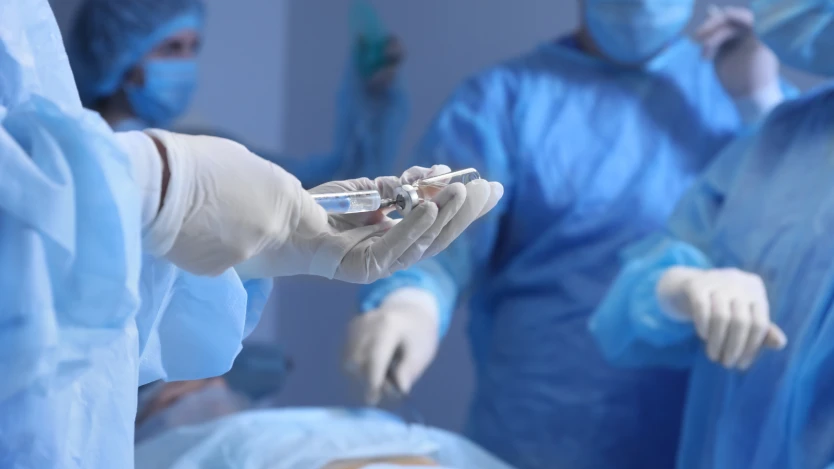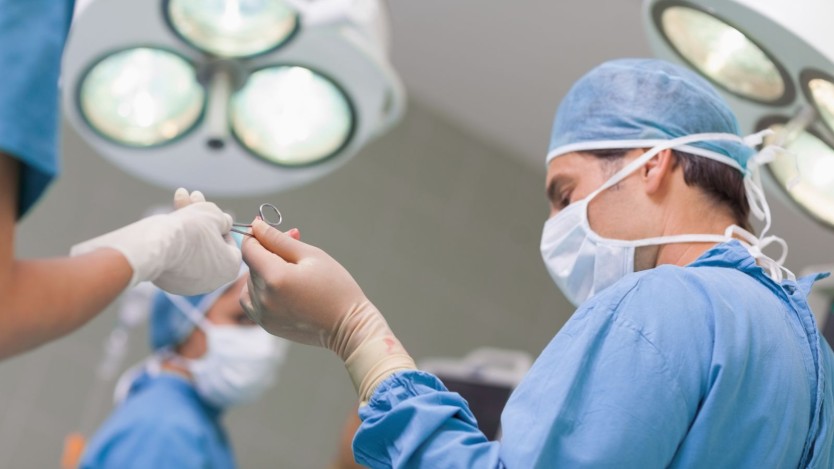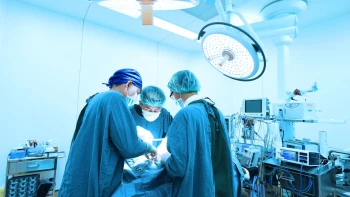What is the anaesthesia used for meniscus surgery?

- What does the preoperative meniscus surgery consist of?
- Prior consultation with the anaesthetist
- Types of anaesthesia for meniscus surgery
- Anaesthesia during meniscus surgery by arthroscopy
- Risks of anaesthesia in meniscus surgery
- Request a free consultation for meniscus surgery
- Do you have any questions? Free assessment on contracting medical services
- Meniscus surgery is mainly performed by arthroscopy, which is a minimally invasive surgical technique.
- This procedure is always performed under anaesthesia, although it is usually performed under general or regional anaesthesia.
- In this article we will explain everything you need to know about the anaesthesia used in meniscus surgery by arthroscopy.
Meniscus surgery consists of repairing injuries suffered in one of the menisci of the knee, we have two, which may require the removal of the affected piece, which we call meniscectomy, as well as the suturing of the injury, meniscal suture.
The use of one technique or the other will depend on the area of the meniscus affected, although it is usual for both to be used at the same time, as tears do not usually occur in just one part of the meniscus. You can find out more about meniscus injuries in our article on meniscopathy.
Once the patient has had the consultation with the Specialist in Traumatology and Orthopaedic Surgery and it has been decided that surgery is necessary, a complete preoperative procedure must be carried out, which we explain below:
What does the preoperative meniscus surgery consist of?
As with any operation, a preoperative examination must be performed before the operation is carried out to ensure that the surgery is performed as safely as possible and that the patient is fit to undergo a surgical procedure of this nature.
Usually, the preoperative meniscus surgery preoperative includes 3 tests:
- Complete blood analysis: With this test, the aim is to confirm that the patient has no signs of infection, as this can lead to postoperative complications.
- Electrocardiogram: This test allows us to know the health of the patient's heart and whether it is capable of withstanding an operation of these characteristics as well as the anaesthesia that may be required.
- Chest x-ray: This test determines that the patient's trachea is well positioned and ensures that there are no signs of infection.
After obtaining the results of all these tests, it will be necessary to have a consultation with the anaesthesiologist to determine whether or not the patient is fit for the surgery.

Do you need knee meniscus surgery?
Request a free and immediate appointment with our specialists
Prior consultation with the anaesthetist
The anaesthesia consultation will normally include a review of the patient's medical history, whether the patient has had previous surgeries, both in the area or otherwise, as well as a review of the preoperative results in case there is any information that contraindicates the intervention.
In addition, the anaesthesiologist will usually ask a battery of questions such as lifestyle habits, whether the patient smokes or drinks regularly or if he/she has allergies, family history, heart problems, etc.
With all this information, the anaesthesiologist will determine whether the patient is suitable for the operation and will proceed to establish the type of anaesthesia to be used.

In addition to the above, there are a series of recommendations prior to meniscus surgery, associated with anaesthesia in many cases, which must be taken into account, and which we explain in this article.
The most common is to use spinal or regional anaesthesia together with sedation, but it is also possible to perform the meniscus operation with another type of anaesthesia. Below we explain the different types of anaesthesia that can be used for meniscus surgery by arthroscopy.
Types of anaesthesia for meniscus surgery
As previously mentioned, the most commonly used anaesthesia for meniscus surgery by arthroscopy is spinal or regional anaesthesia, although there are some cases in which other types of anaesthesia are used. The different types of anaesthesia are discussed below:
Local anaesthesia
This type of anaesthesia is not used in practically all cases, as it makes the surgery more difficult and it may be necessary to change the anaesthesia halfway through the operation. This is why spinal or general anaesthesia is usually used.
Spinal anaesthesia
This anaesthesia consists of numbing only the lower part of the patient's body, allowing surgeons to perform the intervention without major problems and without the need to intubate the patient, as is the case with general anaesthesia. When spinal anaesthesia is used, sedation is also usually administered to the patient to relax them and allow the operation to pass quickly.
Spinal anaesthesia is performed by introducing the anaesthetic drugs safely into the spinal canal. After this, the patient begins to feel the loss of sensation in the lower part of the body, from the waist down, and then sedative drugs are administered intravenously to make the stay in the operating theatre more bearable.
As we have already mentioned, this is usually the anaesthesia of choice.
General anaesthesia
Although its use is common, it is not always necessary, since spinal anaesthesia is sufficient. It is important to note that the surgeon, together with the anaesthesiologist, usually chooses the type of anaesthesia based on the characteristics of the surgery and the patient.
In this case, general anaesthesia is usually administered through a line in the arm, although it can be combined with the inhalation of anaesthetic gases. When general anaesthesia is used, the patient is intubated to allow him/her to breathe during the operation and to avoid postoperative respiratory complications.
Anaesthesia during meniscus surgery by arthroscopy
On the day of the meniscus surgery, before entering the operating theatre, the patient is called to a pre-operative room where he/she will be provided with operating clothes and a line will be placed in his/her arm, through which sedation or, in the case of general anaesthesia, anaesthetic drugs will be administered.
In the operating theatre, you will meet the surgeon, the anaesthesiologist and other members of the medical team who will assist you during the operation.
Meniscus surgery is performed under spinal anaesthesia via a lumbar puncture.
Throughout the surgery, the patient will be monitored at all times by the anaesthesiologist, who will regulate and control the patient's vital signs at all times.

When the anaesthesia takes effect, the surgery begins, and when the operation is completed, the patient is awakened.
Risks of anaesthesia in meniscus surgery
The complications and risks associated with anaesthesia, both in meniscus surgery and in any other operation, are usually directly related to age, associated diseases such as heart disease or diabetes, as well as obesity or alcohol consumption. Even so, the medical and anaesthesia team carries out an exhaustive control during the surgery to minimise possible problems.
One of the risks of anaesthesia is allergic reactions to anaesthetic drugs, although this is practically never the case, as it is checked beforehand.
In the case of postoperative respiratory problems, these tend to occur mainly when general anaesthesia is used, although intubation and deep breathing exercises minimise the possibilities.
Likewise, any doubts that the patient may have about anaesthesia it is important that they ask the surgeon during the consultation prior to the operation in order to obtain all the information and thus make the decision to have the operation with the utmost safety.
In the case of Operarme, if you are thinking of having surgery, you can meet one of our specialists during a surgical assessment consultation and ask him/her the pertinent questions about anaesthesia. Here is how to request this consultation.
Request a free consultation for meniscus surgery
If you are thinking of having surgery with us, remember that you can request an immediate and free assessment consultation with one of our orthopaedic surgeons to get to know you, to familiarise yourself with your case and together you can decide on the best way to solve your problem.
To request a consultation you can click on the image below:

Do you need meniscus surgery?
Request a free and immediate appointment with our specialists in traumatology
Do you have any questions? Free assessment on contracting medical services
Before requesting an appointment with our specialist, you may want to know a little more about the whole process at Operarme. For this reason, we offer you a free assessment service so that you can solve any questions you may have:
- How is the surgery managed?
- What services are included?
- Can it be financed?
- What do I do if I don't have the tests?
- What are the advantages of being a patient of Operarme?
Request the service by clicking below and our patient service team will contact you by phone within 24 working hours. This service is non-binding. Don't think twice and request it by clicking below:

Free Assessment for Contracting Medical Services
Operarme’s Patient Service will contact you and solve all your questions on the medical service you need.
Medical disclaimer: All the published content in Operarme is intended to disseminate reliable medical information to the general public, and is reviewed by healthcare professionals. In any case should this information be used to perform a diagnosis, indicate a treatment, or replace the medical assessment of a professional in a face to face consultation. Find more information in the links below:



